Randy Shilts, And the Band Played On: Politics, People, and the AIDS Epidemic. St. Martin’s Press, 1987.
There are a few books on my shelf that I can read any given number of times without being bored or impatient. One of these is And the Band Played On, a painstaking work of journalism that never feels laborious in the reading — despite being in excess of 600 pages.
Randy Shilts, who was a reporter for the San Francisco Chronicle reporting on AIDS in the early 1980s, assembled an intricate chronological telling of the early unfolding of the AIDS epidemic, from the first glimmerings of awareness of a new disease among doctors, public health workers, and trackers of epidemics, to the reactions of people in communities hit by this new disease (especially the gay communities in New York City and San Francisco), to the responses of politicians and policy makers who, almost without exception, dropped the ball.
Category Archives: Book review
Friday Sprog Blogging: book review of ‘Tentacles! Tales of the Giant Squid’.
The foreshadowing last week was accurate. This week, we offer a review of Tentacles! Tales of the Giant Squid by Shirley Raye Redmond with illustrations by Bryn Barnard.
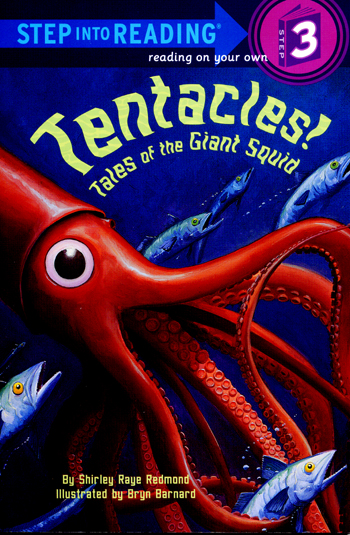
Younger offspring: We should talk about my new squid book for the Friday Sprog Blog.
Dr. Free-Ride: OK. What do you like about this book?
Younger offspring: (Gazing at the cover) I like the cute face of the giant squid.
Dr. Free-Ride: You think that’s a cute face, huh?
Book review: Intuition.
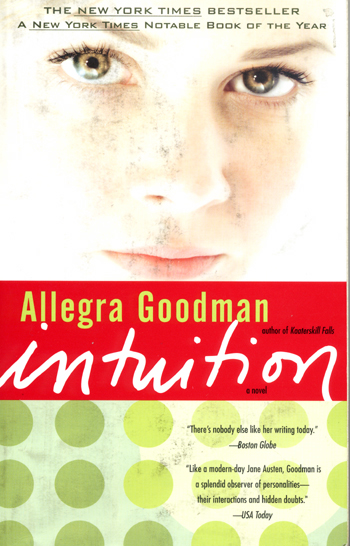
Allegra Goodman’s novel Intuition was published in 2006, and although I heard very good things about it, I was busy enough with other stuff that I didn’t chase down a copy to read it. Finally, last November, my department chair lent me her copy, insistent that I had to read it when I got a chance — not for any academic purpose, but to do something nice for myself. Between semesters, I finally got a chance to read it.
I have a really good department chair.
Book review: The Canon.
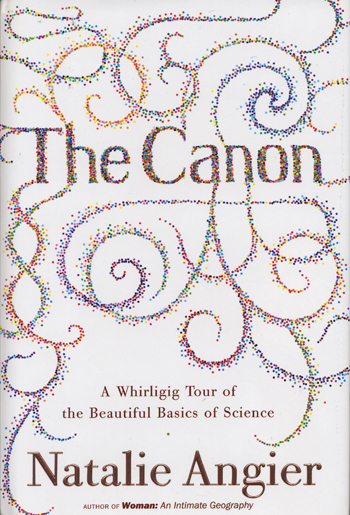
The average American’s lack of scientific literacy has become a common complaint, not only among scientists but also among those who see our economic prospects as a nation linked to our level of scientific know-how. Yet somehow, science has become an area of learning where it’s socially acceptable to plead ignorance. Adults leave the house without even a cocktail-party grasp of the basics they presumably learned in middle school and high school science classes, and the prospects of herding them back into a science classroom to give it another go seem pretty remote.
Natalie Angier’s new book The Canon seeks to provide an audience of adults with the central ideas in physics, chemistry, biology, geology, and astronomy, as well as a reasonable handle on the activity of science more generally. Angier is not presenting a textbook for a survey course, but rather a taste of how these different scientific disciplines understand various chunks of the world we live in. The audience she is trying to reach may fear science, or remember it as boring, or have no good story about how it connects with everyday life. Angier is relentless in identifying science as it crosses our paths, and it is clear that she is taken with the beauty in the scientists’ accounts of their phenomena. What is less clear is whether Angier’s rhapsody to science will really engage her intended audience.
Book review: Storm World.
 When I was growing up in New Jersey, hurricanes were “on the radar” for us, one of many possible (if infrequent) weather patterns during summer and fall. Later, in my first semester of college in Massachusetts, the morning of my first broadcast on the college radio station was made memorable by the landfall of Hurricane Gloria; I remember the name of the storm because I closed my show by playing the U2 song “Gloria” before signing off the air at 7 am. (The governor of the Massachusetts had just declared a state of emergency, although it wasn’t until some 30 minutes later that the trustees of the college decided it might be a good idea to cancel classes.) The Atlantic coast, and the inland area not too far from it, was a site of weather events that commanded your attention.
When I was growing up in New Jersey, hurricanes were “on the radar” for us, one of many possible (if infrequent) weather patterns during summer and fall. Later, in my first semester of college in Massachusetts, the morning of my first broadcast on the college radio station was made memorable by the landfall of Hurricane Gloria; I remember the name of the storm because I closed my show by playing the U2 song “Gloria” before signing off the air at 7 am. (The governor of the Massachusetts had just declared a state of emergency, although it wasn’t until some 30 minutes later that the trustees of the college decided it might be a good idea to cancel classes.) The Atlantic coast, and the inland area not too far from it, was a site of weather events that commanded your attention.
For nearly two decades now, I’ve lived in California, in an area described as having climate, not weather. When I started reading Chris Mooney’s new book Storm World, a part of me wondered whether the fact that hurricanes are no longer a part of my day to day life would make it harder for me to get into this book about the scientific efforts to understand and forecast hurricanes, and the political struggles around the science.
My worry was misplaced.
Book review: The Ethical Chemist.

People sometimes worry that throwing ethics coursework at scientists-in-training is not such a great strategy for training them to be ethical scientists. (I’ve explored worries of this sort myself.)
For one thing, at many schools the existing coursework may be a fairly broad “moral issues” course aimed at understanding what it means to be a good person rather than a good scientist.* Or the ethics course on the books may have more to do with meta-ethics (the examination of various theoretical frameworks grounding claims about what is good and what is bad) rather than practical ethics. And if the instructor for the course comes from a non-science discipline (like philosophy or religious studies) and is teaching from texts from that discipline, there’s a good chance that the student will ask herself, “What does any of this have to do with being an ethical scientist?”
Chemist Jeffrey Kovac’s book The Ethical Chemist: Professionalism and Ethics in Science is a text that, for those charged with teaching ethics to chemistry students, aims to sidestep these worries.
Book review: Generation Rx.
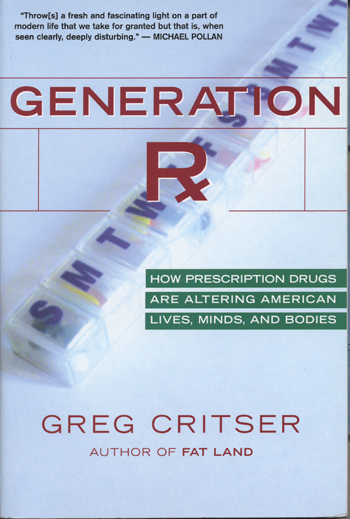 I recently finished reading Greg Critser’s Generation Rx: How Prescription Drugs Are Altering American Lives, Minds, and Bodies.
I recently finished reading Greg Critser’s Generation Rx: How Prescription Drugs Are Altering American Lives, Minds, and Bodies.
Frankly, I don’t feel so well.
Book review: Scientific Misconduct and Its Cover-Up – Diary of a Whistleblower.
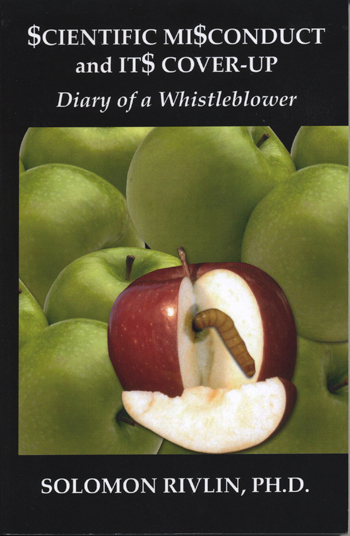 I recently read a book by regular Adventures in Ethics and Science commenter Solomon Rivlin. Scientific Misconduct and Its Cover-Up: Diary of a Whistleblower is an account of a university response to allegations of misconduct gone horribly wrong. I’m hesitant to describe it as the worst possible response — there are surely folks who could concoct a scenario where administrative butt-covering maneuvers bring about the very collapse of civilization, or at least a bunch of explosions — but the horror of the response described here is that it was real:
I recently read a book by regular Adventures in Ethics and Science commenter Solomon Rivlin. Scientific Misconduct and Its Cover-Up: Diary of a Whistleblower is an account of a university response to allegations of misconduct gone horribly wrong. I’m hesitant to describe it as the worst possible response — there are surely folks who could concoct a scenario where administrative butt-covering maneuvers bring about the very collapse of civilization, or at least a bunch of explosions — but the horror of the response described here is that it was real:
The events and personalities described in the following account are real. Names and places were changed to protect the identity of the people who took part in this ugly drama …
I wish I could say that the events described in this book came across as unrealistic. However, paying any attention at all to the world of academic science suggests that misconduct, and cover-ups of misconduct, are happening. Given the opacity of administrative decision making, it’s impossible to know the prevalence of the problem — whether this is just a case of a few extraordinarily well-connected bad actors, or whether the bad actors have come to dominate the ecosystem. In any case, an inside look at how one university responded to concerns about scientific integrity gives us some useful information about features of the academic culture that can constrain and impede efforts to hold scientists accountable for their conduct.
Scientific plausibility of Never Let Me Go.
Since it has come up in the comments on my review of Kazuo Ishiguro’s novel Never Let Me Go, I’m going to go ahead and discuss some of the issues around cutting-edge biomedical technologies in the book that might, or might not, be plausible when pondered. (As Bill points out, the scientific details in the novel itself are pretty minimal — the focus is squarely on the interactions between characters — so plausibility is only an issue if you’re not good at suspending disbelief.)
WARNING: This post will be packed with spoilers!
Unless you’ve already read the book, or you have sworn a blood-oath never to read the book, you really should skip this post.
Book review: Never Let Me Go.

Last May, on my way back from a mini-conference in Stockholm, I had a long layover in Munich. Since major airports are now essentially shopping malls with parking for commercial jets, I used a little bit of that time to wander through a pretty impressive airport book store, where I picked up a copy of Never Let Me Go by Kazuo Ishiguro. I had heard a bit about it (maybe in reviews on the radio, if memory serves), and knew that it had some connection to ethical issues around biomedical technologies that seem not to be too far off from where we are now.
Because I was taking a stab at using my layover time wisely, though, I spent the hours at the airport reading a couple of other books I had promised to review for journals. Then, once on the plane, I slept. Then, I was back home fighting the twin demons of end-of-semester grading and jet lag.
A couple days ago, while straightening up some piles of books, I found Never Let Me Go and decided I needed some “me-time” reading a novel. Less than 48 hours later, I was finishing it and wondering what would count as a decent interval to wait before rereading it.
It’s a very good book. I’ll try to explain why without giving away too much, since a lot of the pleasure of reading this book is the way in which the reader comes into possession of key details as the story unfolds.
